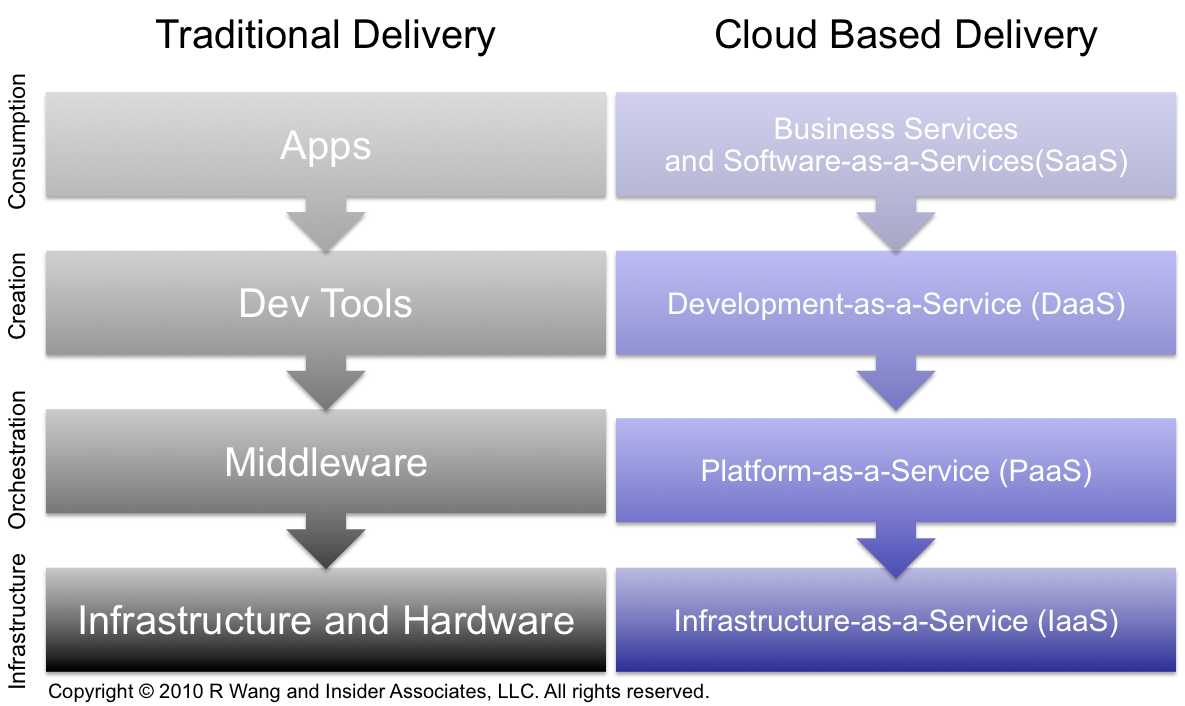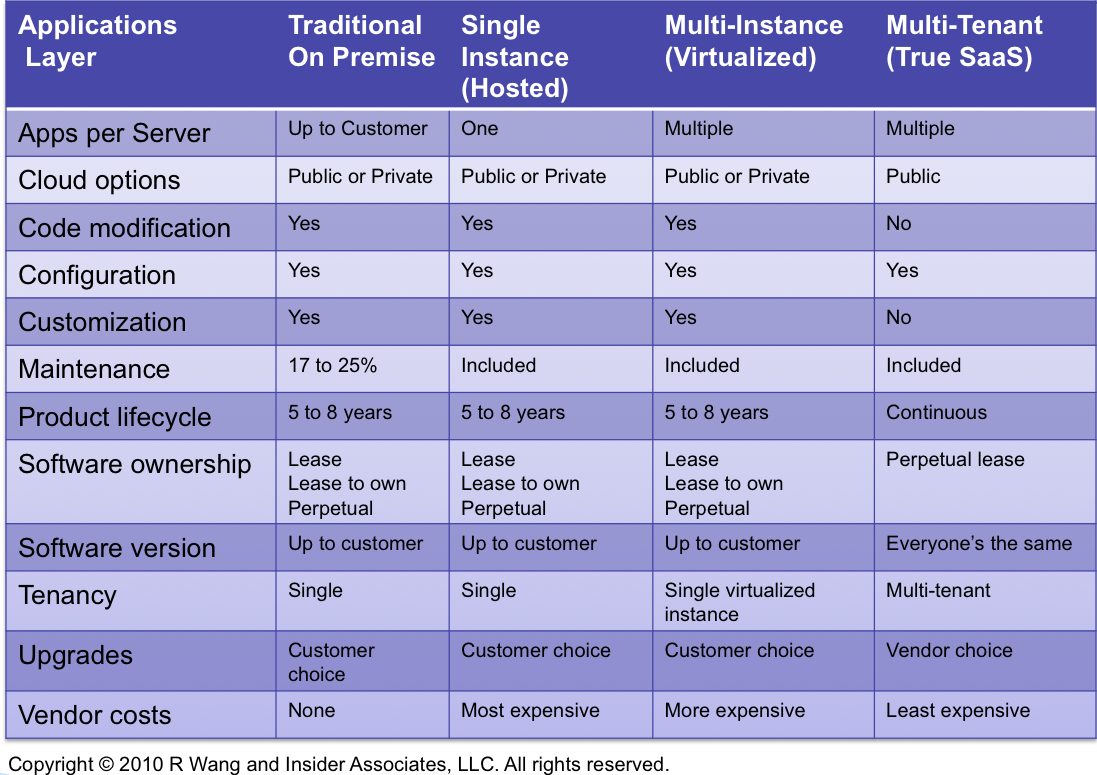Tuesday's Tip: Understanding The Many Flavors of Cloud Computing and SaaS
Confusion Continues With Cloud Computing And SaaS Definitions
Coincidence or just brilliance must be in the air as three esteemed industry colleagues, Phil Wainewright, Michael Cote, and James Governor, have both decided to clarify definitions on SaaS and Cloud within a few days of each other. In fact, this couldn't be more timely as SaaS and Cloud enter into mainstream discussion with next gen CIO's evaluating their apps strategies. A few common misconceptions often include:
- "That hosting thing is like SaaS"
- "Cloud, SaaS, all the same, we don't own anything"
- "OnDemand is Cloud Computing"
- "ASP, Hosting, SaaS seems all the same"
- "It all costs the same so what does it matter to me?"
- "Why should I care if its multi-tenant or not?
- "What's this private cloud versus public cloud?"
Cloud Computing Represents The New Delivery Model For Internet Based IT services
Traditional and Cloud based delivery models share 4 key parts (see Figure 1):
- Consumption - how users consume the apps and business processes
- Creation - what's required to build apps and business processes
- Orchestration - how parts are integrated or pulled from an app server
- Infrastructure - where the core guts such as servers, storage, and networks reside
As the über category, Cloud Computing comprises of
- Business Services and Software-as-a-Service (SaaS) - The traditional apps layer in the cloud includes software as a service apps, business services, and business processes on the server side.
- Development-as-a-Service (DaaS) - Development tools take shape in the cloud as shared community tools, web based dev tools, and mashup based services.
- Platform-as-a-Service (PaaS) - Middleware manifests in the cloud with app platforms, database, integration, and process orchestration.
- Infrastructure-as-a-Service (IaaS) - The physical world goes virtual with servers, networks, storage, and systems management in the cloud.
Figure 1. Traditional Delivery Compared To Cloud Based Delivery

The Apps Layer In The Cloud Represents Many Flavors From Hosted To True SaaS
SaaS purists often challenge vendors on delivery models in the cloud at the apps layer (see Figure 2). Often classified as OnDemand, there are 3 common approaches:
- Single Instance - (a.k.a. “On Demand”). Think traditional apps deployed one cusotmer per app or per server. Many vendors provide hosting capabilities. Customers don’t worry about the IT infrastructure and retain the flexibility to modify, customize, and in most cases choose when they want to change the code. All customers can use different versions of the software
- Multi Instance - (a.k.a. “Server Virtualized”). Think “VMware” like. Apps deployed into a shared-web hosting environment. A single instance copy of the app is configured and deployed into a web directory for each customer. Vendor benefit from easier to manage multi-instance environments. Customers don’t worry about the IT infrastructure and retain the flexibility to modify, customize, and in most cases choose when they want to change the code. All customers can use different versions of the software.
- Multi-tenant - (a.k.a. “True SaaS”). Apps in a multi-tenant deployments provide a single operating environment shared by multiple customers. Config files are created and deployed each time a customer request services. Customers don’t worry about the IT infrastructure and retain the flexibility to modify, configure but NOT customize the code. Customers usually receive upgrades at the same time. Everyone shares the same code.
Figure 2. Different Strokes Of OnDemand For Different Folks

The Bottom Line - Different Models Bring Varying Degrees Of Trade Offs In Cost Versus Flexibility
Keep in mind there are cases where one deployment option is more favorable than another. Just because you are multi-tenant SaaS doesn’t mean you are better. On the other hand, when vendors tout OnDemand as a SaaS offering, then the SaaS bigotry begins. Be on the look out as more vendor provide mix-mode offerings to support disconnected modes, SaaS and On-premise, Public and Private clouds, as well as other improvements in integration with stronger client side ESB’s. Expect many vendors to put their offerings into the Cloud as Cloud/SaaS moves beyond the mainstream for apps strategy. Let's take a look at a two decision criteria:
Scenario 1: From least expensive to most expensive to run for a vendor:
- True SaaS
- Server Virtualized
- Hosting
Why is this important? Let’s see, you choose a Hosted solution and the vendor’s costs to run the app goes up with each new customer as it has to manage the different environments. No matter how hard the vendor will try to “fit” everyone to standard configurations and deployments, that’s not always possible. Flexibility has a cost. In a “True Saas” solution, the cost to add an additional customer is minimal and each customer reduces the overall cost for everyone. Ultimately, a True SaaS deployment will have the lowest cost/user/month fee. What will you do 5 years into an Hosting scenario when you are locked in?
Scenario 2: From most customizable to least customizable for a customer:
- Hosting
- Server Virtualized
- True SaaS
Why is this important? Your may have specific needs in an area where the SaaS vendor has not provided the deepest level of configurations. You can’t just go in and modify the code unless everyone else wants it or the vendor’s has it on the roadmap. The cost of comformity is the lack of flexibility. What will you do 5 years into a True SaaS scenario when you are locked in and the vendor won’t add the feature or functionality you need?
Your POV
What's your view on SaaS vs Cloud? Does this help clarify the definitions? Are you looking at private, public, or hybrid cloud options? Add your comments to the discussion or send on to rwang0 at gmail dot com or r at softwaresinsider dot org and we’ll keep your anonymity.
Please let us know if you need help with your SaaS/Cloud strategies. Here’s how we can help:
- Crafting your next gen apps strategy
- Short listing and vendor selection
- Contract negotiations support
- Market evaluation
Related resources and links
Take the new and improved survey on 3rd party maintenance
20100322 Monkchips - James Governor "Defining Cloud is Simple. Get Over It. The Burger"
20100319 ZD Net: Software as Services - Phil Wainewright "Is SaaS the Same as Cloud"
Copyright © 2010 R Wang and Insider Associates, LLC. All rights reserved.
 R "Ray" Wang
R "Ray" Wang R "Ray" Wang
R "Ray" Wang